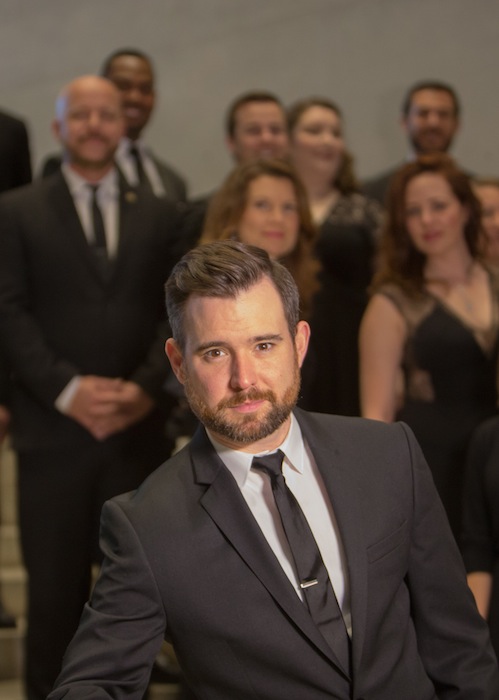A mixed bag of Latin-American Baroque from Seraphic Fire

Patrick Quigley conducted Seraphic Fire Saturday night at All Saints Episcopal Church in Fort Lauderdale.
The early Spanish and Portuguese ships that came to the Americas in the 16th and 17th centuries carried more than just soldiers, priests and fortune seekers.
They brought musicians. And as the new arrivals turned their rough colonies into outposts of European civilization, the churches of Havana, Cartagena and Rio de Janeiro resounded with the tones of Baroque and Renaissance music.
The legacy of early Latin American music is the focus of Seraphic Fire’s current program, titled “Barroco: Latin American Baroque.” Led by artistic director Patrick Dupré Quigley, Saturday night’s concert at All Saints Episcopal Church in Fort Lauderdale shed light on a little-known period in the history of classical music, when composers trained in European techniques worked in the tropical world of the Americas.
Some of the compositions sounded more workmanlike than inspired, distinctive less for their musical merit than for the time and place in which they were composed. Others carried a unique tone, with their combination of European styles with the languages and sensibilities of the New World.
The choir performed with its usual virtuosity and flexibility of style, plausibly bringing to life this era. A small period-instrument chamber orchestra accompanied the choir, providing tones and textures that helped evoke another time and place.
Despite the concert’s focus on the past, it opened with a world premiere. The choir performed Tu, paz mia by the Cuban-born composer Ileana Perez Velazquez, now professor of music composition at Williams College.
Processional and solemn, the work is Baroque in tone if not in harmonic language, making an effective opening for a concert devoted to its predecessors. Composed for unaccompanied chorus, it made the most of Seraphic Fire’s purity of tone, with transparent slow-moving chords. Beginning with harmonies that sounded as if from another century, the work quickly became more modern and complex, proceeding to agitated passages of uneasy tones before settling back to a hard-won tranquility.
The Baroque period ended sooner in Europe than in Latin America, where the innovations of the Classical period arrived late and many composers in the late 18th century still wrote in the older style. Among these was Esteban Salas y Castro, a contemporary of Haydn who is considered the father of Cuban classical music. Head of music at the cathedral of Santiago de Cuba, Salas composed sacred and secular music for Cuba’s churches and grand houses. Today, the music conservatory in Santiago de Cuba is named in his honor.
His Salve Regina, a Latin prayer to the Virgin Mary, was a grave work that took surprising harmonic turns to evoke religious mystery and faith. Sobre los ríos undosos was more upbeat, with the recorder and other instruments of the orchestra creating a texture that felt older in style. Assumpta est was a skillful, if not particularly interesting, traditional work.
The choir performed three Salas works that were examples of a form called the villancico, a rustic vocal work that set both secular and religious texts. These had an informality and playfulness that contrasted with their more rigid European counterparts. In “Venga el mundo todo,” tenor Patrick Muehleise provided a smooth, easy solo, his voice popping out of the chorus for a few notes here and there. But there were also a lot of passages in these works that felt busy but not particularly interesting, skillful exercises in traditional composition without much musical inspiration or individuality.
Among the more intriguing works on the program were those composed to evangelize the indigenous people of the Americas through the use of local languages. An anonymous composition of 17th century Peru called “Hanacpachap,” for example, was sung in the Quechua language of the Incas. Performed to a constant drumbeat, the work had a stern and dramatic tone, with the distinctive vowels and consonants giving it an earthy force.
“Xicochi Conetzintle,” by the Renaissance-era Portuguese composer Gaspar Fernandes, uses the Nahuatl language of Mexico and Central America (although he appends the Hebrew word Alleluia at the end). Gentler in tone than the previous work, it uses piquant rhythms and distinctive melodic turns to get across the lullaby-like words of the text.
Aside from using indigenous languages, some of the works gained strength through the vigorous rhythms of what appeared to be emerging as distinctively Latin American musical styles.
“¡Fuera, fuera! ¡Háganles lugar!” by the Bolivian composer Roque Jacinto de Chevarria (1688-1719) used voices almost percussively to bring an exhilarating momentum to the music. Particularly effective was the contribution of percussionist Rex Benincasa, whose maracas, castanets, tambourine, drum and other instruments provided much of the texture and force for the evening’s works.
The anonymous composition “Vamos a Belén todos a bailar” presented a distinctly Latin American tone of religious joy with its dance-like rhythms and rapped out cries of “Ay, Ay, Ay!”
The program will be repeated 4 p.m. Sunday at Vanderbilt Presbyterian Church in Naples. seraphicfire.org
Posted in Performances
Leave a Comment
Sun Apr 14, 2019
at 11:50 am
No Comments






